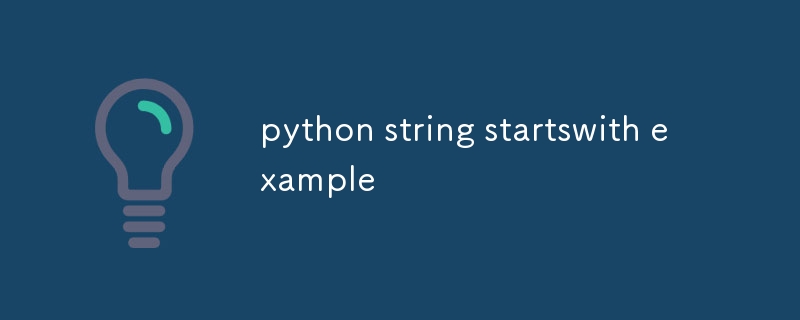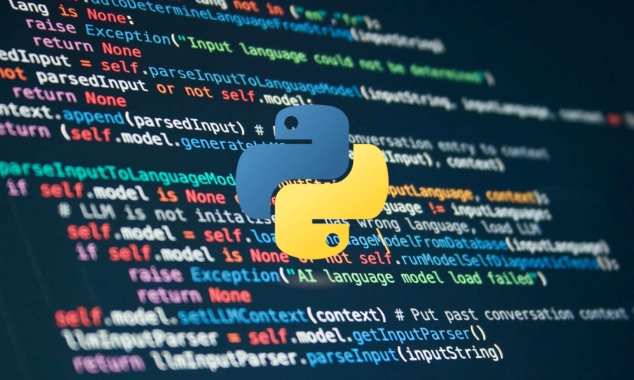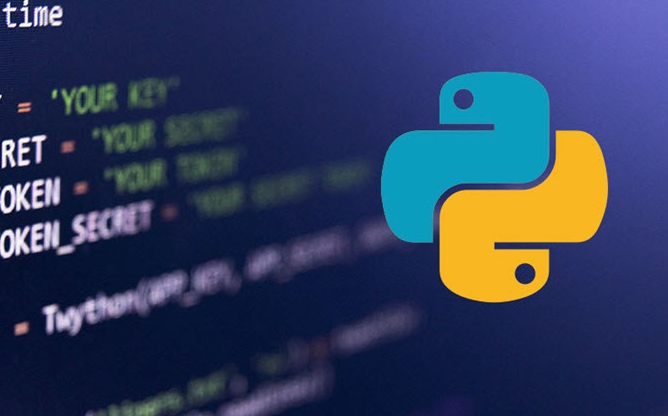The startswith() method in Python is used to check whether a string starts with a specified prefix and returns True or False; 1. You can check a single prefix, such as text.startswith("Hello") to return True; 2. You can pass in a tuple to check multiple prefixes, such as url.startswith(("http://", "https://")) to determine whether it is a web link; 3. You can specify the start and end parameters to limit the inspection range, such as text.startswith("Python", 7) to start matching at a specified location; this method is often used to filter logs, judge command types and other scenarios, and can efficiently handle text matching issues with endswith().

startswith() method in Python is used to check whether the string starts with the specified prefix and returns a boolean value True or False . This method is very practical when processing text data, such as judging file types, filtering inputs in specific formats, etc.

Basic syntax
string.startswith(prefix[, start[, end]])
-
prefix: The prefix to be checked can be a string or a tuple (multiple prefixes) -
start(optional): The starting position of the check -
end(optional): the end position of the check
1. Check for single prefix
The most common usage is to determine whether a string starts with a certain character or substring.
text = "Hello, world!"
print(text.startswith("Hello")) # Output: True
print(text.startswith("World")) # Output: False (case sensitive)2. Check multiple possible prefixes with tuples
You can pass in a tuple to determine whether it starts with any of the prefixes.

filename = "image.png"
if filename.startswith(("http://", "https://")):
print("This is a URL")
elif filename.startswith(("jpg", "png", "gif")):
print("This is a picture file")
else:
print("Unknown Type")
# Output: Unknown type (Note: Here is a match from the beginning, and the extension is at the end)Correction example (correctly judge the extension):
filename = "image.png"
if filename.lower().endswith(("jpg", "jpeg", "png", "gif")):
print("This is a picture file")
# Output: This is an image fileBut if it is to judge the path or protocol, startswith is suitable:

url = "https://example.com"
if url.startswith(("http://", "https://")):
print("This is a web link")
# Output: This is a web link3. Specify the check range (start and end parameters)
You can limit the range of substrings to check.
text = "I love Python programming"
# Start from the 7th character to check whether it starts with "Python" print(text.startswith("Python", 7)) # Output: True
print(text.startswith("love", 2)) # Output: False("love" starts with the second character? No)
print(text.startswith("love", 2, 10)) # Output: True (starts with "love" in the range [2:10])Examples of practical application scenarios
Filter log lines
logs = [
"INFO: User logged in",
"ERROR: Failed to connect",
"INFO: Data saved",
"WARNING: Disk space low"
]
info_logs = [log for log in logs if log.startswith("INFO")]
print(info_logs)
# Output: ['INFO: User logged in', 'INFO: Data saved']Determine the command type
command = input("Please enter the command: ")
if command.startswith("git"):
print("This is a Git command")
elif command == "exit":
print("Exit Program")
else:
print("Unknown Command") Basically these common uses. startswith() is simple and efficient, suitable for string prefix judgment, and combined with endswith() to process the suffix, it can solve most text matching problems.
The above is the detailed content of python string startswith example. For more information, please follow other related articles on the PHP Chinese website!

Hot AI Tools

Undress AI Tool
Undress images for free

Undresser.AI Undress
AI-powered app for creating realistic nude photos

AI Clothes Remover
Online AI tool for removing clothes from photos.

Clothoff.io
AI clothes remover

Video Face Swap
Swap faces in any video effortlessly with our completely free AI face swap tool!

Hot Article

Hot Tools

Notepad++7.3.1
Easy-to-use and free code editor

SublimeText3 Chinese version
Chinese version, very easy to use

Zend Studio 13.0.1
Powerful PHP integrated development environment

Dreamweaver CS6
Visual web development tools

SublimeText3 Mac version
God-level code editing software (SublimeText3)
 Polymorphism in python classes
Jul 05, 2025 am 02:58 AM
Polymorphism in python classes
Jul 05, 2025 am 02:58 AM
Polymorphism is a core concept in Python object-oriented programming, referring to "one interface, multiple implementations", allowing for unified processing of different types of objects. 1. Polymorphism is implemented through method rewriting. Subclasses can redefine parent class methods. For example, the spoke() method of Animal class has different implementations in Dog and Cat subclasses. 2. The practical uses of polymorphism include simplifying the code structure and enhancing scalability, such as calling the draw() method uniformly in the graphical drawing program, or handling the common behavior of different characters in game development. 3. Python implementation polymorphism needs to satisfy: the parent class defines a method, and the child class overrides the method, but does not require inheritance of the same parent class. As long as the object implements the same method, this is called the "duck type". 4. Things to note include the maintenance
 Explain Python generators and iterators.
Jul 05, 2025 am 02:55 AM
Explain Python generators and iterators.
Jul 05, 2025 am 02:55 AM
Iterators are objects that implement __iter__() and __next__() methods. The generator is a simplified version of iterators, which automatically implement these methods through the yield keyword. 1. The iterator returns an element every time he calls next() and throws a StopIteration exception when there are no more elements. 2. The generator uses function definition to generate data on demand, saving memory and supporting infinite sequences. 3. Use iterators when processing existing sets, use a generator when dynamically generating big data or lazy evaluation, such as loading line by line when reading large files. Note: Iterable objects such as lists are not iterators. They need to be recreated after the iterator reaches its end, and the generator can only traverse it once.
 How to handle API authentication in Python
Jul 13, 2025 am 02:22 AM
How to handle API authentication in Python
Jul 13, 2025 am 02:22 AM
The key to dealing with API authentication is to understand and use the authentication method correctly. 1. APIKey is the simplest authentication method, usually placed in the request header or URL parameters; 2. BasicAuth uses username and password for Base64 encoding transmission, which is suitable for internal systems; 3. OAuth2 needs to obtain the token first through client_id and client_secret, and then bring the BearerToken in the request header; 4. In order to deal with the token expiration, the token management class can be encapsulated and automatically refreshed the token; in short, selecting the appropriate method according to the document and safely storing the key information is the key.
 How to iterate over two lists at once Python
Jul 09, 2025 am 01:13 AM
How to iterate over two lists at once Python
Jul 09, 2025 am 01:13 AM
A common method to traverse two lists simultaneously in Python is to use the zip() function, which will pair multiple lists in order and be the shortest; if the list length is inconsistent, you can use itertools.zip_longest() to be the longest and fill in the missing values; combined with enumerate(), you can get the index at the same time. 1.zip() is concise and practical, suitable for paired data iteration; 2.zip_longest() can fill in the default value when dealing with inconsistent lengths; 3.enumerate(zip()) can obtain indexes during traversal, meeting the needs of a variety of complex scenarios.
 What are Python type hints?
Jul 07, 2025 am 02:55 AM
What are Python type hints?
Jul 07, 2025 am 02:55 AM
TypehintsinPythonsolvetheproblemofambiguityandpotentialbugsindynamicallytypedcodebyallowingdeveloperstospecifyexpectedtypes.Theyenhancereadability,enableearlybugdetection,andimprovetoolingsupport.Typehintsareaddedusingacolon(:)forvariablesandparamete
 What are python iterators?
Jul 08, 2025 am 02:56 AM
What are python iterators?
Jul 08, 2025 am 02:56 AM
InPython,iteratorsareobjectsthatallowloopingthroughcollectionsbyimplementing__iter__()and__next__().1)Iteratorsworkviatheiteratorprotocol,using__iter__()toreturntheiteratorand__next__()toretrievethenextitemuntilStopIterationisraised.2)Aniterable(like
 Explain Python assertions.
Jul 07, 2025 am 12:14 AM
Explain Python assertions.
Jul 07, 2025 am 12:14 AM
Assert is an assertion tool used in Python for debugging, and throws an AssertionError when the condition is not met. Its syntax is assert condition plus optional error information, which is suitable for internal logic verification such as parameter checking, status confirmation, etc., but cannot be used for security or user input checking, and should be used in conjunction with clear prompt information. It is only available for auxiliary debugging in the development stage rather than substituting exception handling.
 How to test an API with Python
Jul 12, 2025 am 02:47 AM
How to test an API with Python
Jul 12, 2025 am 02:47 AM
To test the API, you need to use Python's Requests library. The steps are to install the library, send requests, verify responses, set timeouts and retry. First, install the library through pipinstallrequests; then use requests.get() or requests.post() and other methods to send GET or POST requests; then check response.status_code and response.json() to ensure that the return result is in compliance with expectations; finally, add timeout parameters to set the timeout time, and combine the retrying library to achieve automatic retry to enhance stability.






